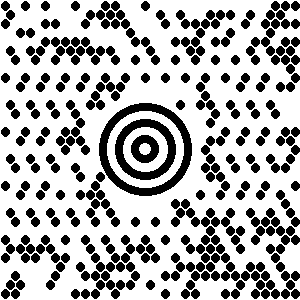|
Zint Barcode Generator |
||
|---|---|---|
Also known as Semacode this symbology can encode a large amount of data in a small area. Any length ASCII string can be encoded up to 780 characters. Symbol size is determined by the length of the input data and Reed-Solomon error correction is added.
![]()
Also known as Quick Response Code this symbology was developed by Denso. QR Code support in Zint relies on libqrencode (version 2.0.0) which is available from http://megaui.net/fukuchi/works/qrencode/index.en.html. Support for QR Code through libzint means that developers only need to write handlers for one API which covers QR Code as well as all of the other code symbologies provided by libzint. Four levels of error correction are available using the security= option or setting option_1 as shown in the following table.
|
Input |
ECC Level |
Error Correction Capacity |
Recovery Capacity |
|
1 |
L (default) |
Approx 20% of symbol |
Approx 7% |
|
2 |
M |
Approx 37% of symbol |
Approx 15% |
|
3 |
Q |
Approx 55% of symbol |
Approx 25% |
|
4 |
H |
Approx 65% of symbol |
Approx 30% |
The size of the symbol can be set by using the vers= option or setting option_2 to the QR Code version required (1-40). The maximum capacity of a (version 40) QR Code symbol is 7089 numeric digits, 4296 alphanumeric characters or 2953 bytes of data.

Developed by UPS the Maxicode symbology employs a grid of hexagons surrounding a 'bulls-eye' finder pattern. This symbology is designed for the identification of parcels. Zint encodes Maxicode symbols in Mode 2 or Mode 3 depending on the postcode data entered. In these modes Maxicode symbols are composed of two parts named the primary and secondary messages. The primary message consists of a structured data field which includes various data about the package being sent, the secondary message usually consists of address data in a data structure. The format of the primary message is given in the following table:
|
Characters |
Meaning |
|---|---|
|
1-9 |
Postcode data which can consist of up to 9 digits (for mode 2) or up to 6 alphanumeric characters (for mode 3). Remaining unused characters should be filled with the SPACE character (ASCII 32). |
|
10-12 |
Three digit country code according to ISO 3166 (see Appendix B). |
|
13-15 |
Three digit service code. This depends on your parcel courier. |
The primary message can be designated at the command prompt using the --primary= switch. The secondary message uses the normal data entry method. For example:
zint -o test.eps -b 57 --primary='999999999840012' -d 'Secondary Message Here'
When using the API the primary message must be placed in the symbol->primary string. The secondary is entered in the same way as described in section 4.2.
Modes 4 to 6 can be encoded using the --mode= switch or by setting option_1. Modes 4 to 6 do not require a primary message. For example:
zint -o test.eps -b 57 --mode=4 -d 'A MaxiCode Message in Mode 4'
Mode 6 is reserved for the maintenance of scanner hardware and should not be used to encode user data. All modes support extended ASCII characters and number compression. The maximum length of text which can be placed in a Maxicode symbol depends on the type of characters used in the text. Example maximum data lengths are given in the table below:
|
Mode |
Maximum Data Length for Capital Letters |
Maximum Data Length for Numeric Digits |
Number of Error Correction Codewords |
|---|---|---|---|
|
2 (secondary only) |
84 |
126 |
50 |
|
3 (secondary only) |
84 |
126 |
50 |
|
4 |
93 |
135 |
50 |
|
5 |
77 |
110 |
66 |
|
6 |
93 |
135 |
50 |
PLEASE NOTE that due to the unique style of the Maxicode symbol not all of the options available for other symbologies are available. Settings for height, whitespace width, border width and output options will be ignored. Colour options are available as with other symbologies. PNG output is set at a resolution of 12 pixels per millimetre (approx 300 dpi) and uses the methods set out in Annex J of the ISO/IEC standard.

|
4-State Codes |
|
Markings |